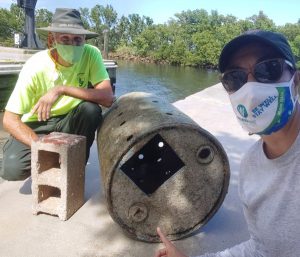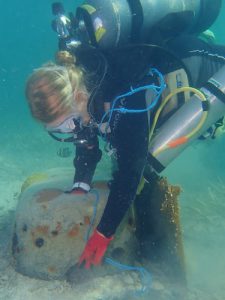Caribbean spiny lobster in Florida
This week marks the two-day lobster mini-season, the always-anticipated sport season for recreational harvest only. In Florida, the Caribbean spiny lobster (Panulirus argus) is a very well-managed fishery. Harvest of lobster can occur in one of two ways: commercial or recreational. Both require a valid fishing license and lobster stamp issued by the Florida Fish and Wildlife Conservation Commission (FWC). Commercial fishing means that the catch is later sold for profit, whereas recreational harvest means that the fisher is harvesting for personal consumption, not re-selling their catch to a fish market or dealer.
Lobster harvest in Florida happens a few different ways: through a legitimate marked and registered trap (commercial fishing only), or via free-diving, SCUBA diving, or bullynetting. Whether recreationally or commercially fishing, all pertinent regulations set forth by FWC must be followed.
Casitas
Commercial lobster traps are constructed of wood with cement on the bottom. They are connected to other traps via line and marked with a buoy at the surface. Legally registered traps contain identification to the fisher.
In other areas of the Caribbean such as Cuba, Mexico and the Bahamas, the use of casitas (Spanish for “little houses”, an artificial structure that is placed in the water) are another fishing tool (Sosa-Cordero et al. 1998). Casitas are not legal for use in Florida or the United States. However, while in the water diving for work or for pleasure, resource managers often encounter illegally-deployed casitas. Artificial reefs of all types are widely known for their ability to attract fish and invertebrates. The argument of attraction (pulling creatures from other places) or production (that these structures are increasing populations) is constantly debated in the scientific community (Bohnsack & Szmant 1997). Whether attraction vs production, fishers know that if they can place certain items in the water, lobsters will come-but at what cost?

Aside from being illegal, casitas present several problems from an ecological perspective. Casitas are often found in shallow water (<20’ deep), which makes them more easily accessible via snorkeling or free-diving. This depth includes not only shallow coral reefs but also seagrass beds, which serve as a critical juvenile lobster habitat. The placement of the casita, usually a PVC pipe, corrugated metal sheets, other tubs or bins can easily move around in the shallow water, causes physical disturbance, damage, and even death to corals, sponges, soft corals, and seagrasses. Casita presence can block sunlight from reaching the organisms, inhibiting growth. This results in overall habitat degradation.

In areas where casitas are permitted, they are intended to attract adult lobsters (Gittens & Butler 2018), but they can unfortunately draw in juvenile lobsters, crabs and others. As such, casita placement can result in multiple negative effects: overcrowding, increased risk of disease, higher risk of predation, reduced food sources, slower lobster growth, and subsequently, higher mortality (Butler & Herrnkind 1997, Gittens & Butler 2018, Gutzler et al. 2015).

Recent targeted casita removal efforts with partners at Biscayne National Park resulted in:
- 2,315 pounds of casita debris removed
- an estimated 150 lobsters and 9 stone crabs released
Casitas are not debris that falls off the side of a boat by accident. They are intentionally placed to capture lobsters by poaching. It is critical to remember that all fishery management regulations are in place to ensure healthy stocks for us not only today, but in the future. As you set out for lobster season this year, please continue to follow the regulations set by FWC. They are available online at https://myfwc.com/fishing/saltwater/recreational/, or use of the “Fish Rules” app. If you would like a hard copy of the July 2021-December 2021 fishing regulations mailed to you, please contact: azangroniz@ufl.edu.
Have a safe and happy lobster season!
References:
Bohnsack, J., Szmant, A. 1997. Artificial reef research: Is there more than the attraction-production issue? Fisheries. Vol 22(4): 14-16
Butler, M., Hernnkind, W. 1997. A test of recruitment limitation and the potential for artificial enhancement of spiny lobster (Panulirus argus) populations in Florida. Canadian Journal of Fisheries and Aquatic Sciences. Vol 54(2): 452-463
Gittens, L., Buter, M. 2018. The effect of casitas on Panulirus argus mortality, growth, and susceptibility to disease in The Bahamas. Bulletin of Marine Science. Vol 94(3): 995-1016
Gutzler, B., Butler, M., Behringer, D. 2015. Casitas: a location-dependent ecological trap for juvenile Caribbean spiny lobsters, Panulirus argus. ICES Journal of Marine Science. Vol 72: i177-i184
Sosa-Cordero, E., Arce, A., Aguilar-Dávila, W., Ramírez-González, A. 1998. Artificial shelters for spiny lobster Panulirus argus (Latreille): an evaluation of occupancy in different benthic habitats. Journal of Experimental Marine Biology and Ecology. Vol. 229, p. 1-18
 1
1
